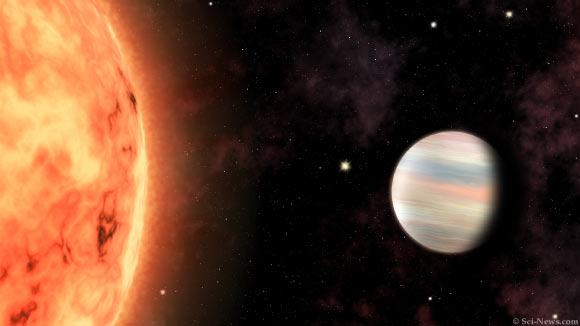TESS Discovers Two New Hot Jupiters | Astronomy – Sci-News.com
Using NASA’s Transiting Exoplanet Survey Satellite (TESS) and several ground-based telescopes, astronomers have observed the transits of two hot-Jupiter exoplanets — one grazing and another fully transiting — around their Sun-like host stars. A paper describing the discovery of these planets will be published in the Astronomical Journal.
Hot Jupiters are gas giants with orbital periods less than 10 days. The short period means that these exoplanets are very close to their parent stars.
Only about 0.5% of stars host a hot Jupiter, about 10% of which have a geometry resulting in a visible transit.
“Transiting hot Jupiters are among the best-studied and the most mysterious classes of exoplanets,” said Yale University astronomer Allen Davis and colleagues in their paper.
“Despite the discovery, confirmation, and characterization of hundreds of these worlds, questions persist as to their mechanisms of formation and orbital evolution.”
“It is not known, for instance, whether hot Jupiters formed beyond the ice line and migrated inwards, or whether they formed close to their present-day orbits.”
The newly-discovered hot Jupiters orbit moderately bright, mid-G dwarf stars: TOI-905 and TOI-564.
TOI-905, also known as TIC 261867566, is approximately 3.4 billion years old and lies 490 light-years from Earth.
The star hosts a classical hot Jupiter with a mass of about 0.67 Jupiter masses and a radius of 1.17 times that of Jupiter.
Named TOI-905b, the planet orbits its star once every 3.74 days.
TOI-564 is 7.3 billion years old and is located approximately 644 light-years away.
Otherwise known as TIC 1003831, it is a probable binary system, with an M-dwarf (red dwarf) companion at a distance of 100 AU.
TOI-564’s only known planet is a classical hot Jupiter as well, with an orbital period of just 1.65 days.
Dubbed TOI-564b, the planet is similar in size to Jupiter but with 1.46 times the mass.
“While TOI-905b fully transits its star, we found that TOI-564b has a very high transit impact parameter of 0.994, making it one of only about 20 known systems to exhibit a grazing transit and one of the brightest host stars among them,” Davis and co-authors said.
A grazing transit is a transit in which only part of the planet’s projected disk occults the disk of its star.
Such systems are very rare — of the more than 3,000 known transiting planets, only about 0.5% exhibit a grazing transit.
“TOI-564b is one of the most attractive systems to search for additional non-transiting, smaller planets by exploiting the sensitivity of grazing transits to small changes in inclination and transit duration over the time scale of several years,” they said.
_____
Allen B. Davis et al. 2019. TOI 564 b and TOI 905 b: Grazing and Fully Transiting Hot Jupiters Discovered by TESS. AJ, in press; arXiv: 1912.10186






